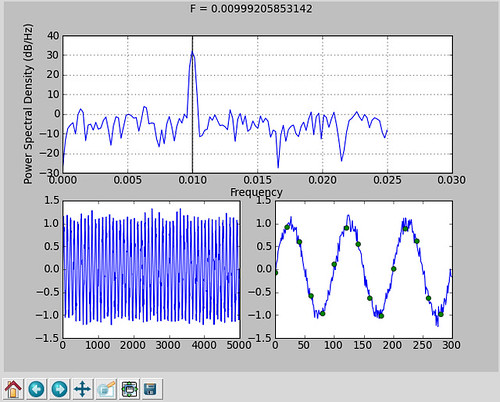Estimate frequency using Numpy
Numpy/Scipy doesn’t have function for estimating frequency (pitch) of given 1D time series, but simple functions can do this. I use a very simple method called “Pisarenko Harmonic Decomposition”. On the picture above, I estimate the frequency of sine curve + noise. The estimate (vertical black line on the top panel) is matched to maximum of the power spectral density. Note that argument x of function freq must satisfy x.mean() == 0.
import numpy
PI = numpy.pi
def covariance(x, k):
N = len(x) - k
return (x[:-k] * x[k:]).sum() / N
def phd1(x):
"""Estimate frequency using Pisarenko Harmonic Decomposition"""
r1 = covariance(x, 1)
r2 = covariance(x, 2)
a = (r2 + numpy.sqrt(r2 ** 2 + 8 * r1 ** 2)) / 4 / r1
if a > 1:
a = 1
elif a < -1:
a = -1
return numpy.arccos(a)
def freq(x, sample_step=1, dt=1.0):
"""Estimate frequency using `phd1`"""
omega = phd1(x[::sample_step])
return omega / 2.0 / PI / sample_step / dt
I posted full source code to get the picture above here: gist: 565034 - GitHub.
You can find the formulation of Pisarenko Harmonic Decomposition method here: CiteSeerX — AN UNBIASED PISARENKO HARMONIC DECOMPOSITION ESTIMATOR FOR SINGLE-TONE FREQUENCY.

